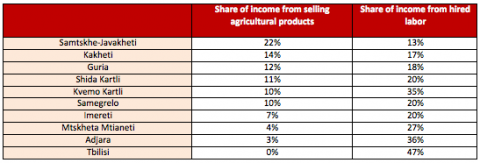In his blog post “The puzzle of agricultural productivity in Georgia and Armenia” , Adam Pellillo raises the following question:
Georgia seems to be the only former Soviet republic in which agricultural productivity hasn’t returned to or exceeded its level in 1992. As of 2010, agricultural productivity stood at only 77 percent of where it was at nearly two decades ago. Why hasn’t agricultural productivity improved in Georgia over the past two decades, while it has at least recovered in every other former Soviet republic? It is even more puzzling to consider why agricultural productivity has grown by nearly 200 percent in Armenia since 1992, while it has declined in Georgia since then.
Adam’s post drew quite a few reactions from the agricultural business and economics community. These fell into three categories.
Type A reactions focused on the reasons (some well known, some less so) for the low productivity in the Georgian ag sector such as “civil war and many years of lawlessness”, “loss of the Russian market”, “land fragmentation and lack of cooperation among small farmers”, “low priority on the government agenda for so many years”, “collapse of irrigation and drainage systems”, “lack of inputs, technology, and knowledge”, “low commercialization of ag. output”.
Type B reactions (fewer in number) focused on what could have worked so well in Armenia. Possible candidates are “better utilization of Soviet era infrastructure, including irrigation”, “higher concentration of agricultural machinery”, “better ability of the country’s processing industry – such as the local brandy industry – to add value”.
Type C reactions, including one by Adam himself, were somewhat skeptical about the accuracy of the underlying data. For instance, an Armenian economist commented that “when comparing the rural life stories of our Georgian and Armenian students I did not get the feeling that the Armenian farmers’ standard of living is several times higher than that of their Georgian partners. Both groups are more similar than different to each other”.
To find the truth, we consulted two senior international statisticians working to improve the quality of agricultural statistics in Georgia and Armenia. Both tend to subscribe to the skeptical view. In particular, they suggested that the Georgian agricultural statistics are based on a rigorous survey of farmers that draws a fairly accurate picture of output and productivity concerning all the main crops. The Armenian ag statistics, on the other hand, are collected using a “reporting system based on community books that may still be influenced by the Soviet style of thinking, with a political pressure to report about increased production levels”.
Now, if Armenian statistics are truly unreliable what’s the point in using Armenia as a benchmark for Georgia (or any other country for that matter)? In despair, we turned to the (higher value) Georgian statistics.
Georgia consists of several regions all of which (except Tbilisi) have a very sizeable share of the labor force (self) employed in agriculture. The regions specialize in different types of agricultural production (crops, husbandry) due to radically different climate and soil conditions. Now, since productivity changes could not have been uniform across all subsectors, we thought that something interesting could be learned about the puzzle of agricultural productivity from a comparison of income per household across Georgia’s regions.
To our great surprise, instead of telling us anything about the evolution of agricultural productivity, the data are once again pointing in the Armenian direction. According to 2011 GeoStat household survey data, the region with the highest income per household (857 GEL) is Samtskhe-Javakheti. Not Tbilisi, not Samegrelo or Adjara. Samtskhe-Javakheti.
For those who don’t know, Samtskhe-Javakheti is the only region of Georgia were Armenians are in a majority (Tbilisi has the second largest Armenian population). Reflecting this demographic reality, the GeoStat sample of the Samtskhe-Javakheti region includes 198 Georgian and 477 Armenian families.
One might think that Armenian households are simply larger, but with 3.8 members per household Samtskhe-Javakheti is not far from the national average (3.6).
Samtskhe Javakheti does stand out on a quite a number of parameters reflecting or affecting agricultural productivity:
- The highest share of income (22%) from selling agricultural products (Kakheti is second with 14%). In monetary terms, an average Samtskhe-Javakhetian farmer receives 2.5 time higher income from selling agricultural products than his Kakhetian competitor. Other regions are much further behind.
- The lowest share of income (13%) from hired labor. Kakheti (17%) and Guria (18%) and are second and third on this parameter, far behind Tbilisi with 47% of income from hired labor.
- The largest area used for cultivation by an average household: 0.85 ha in Samtskhe-Javakheti compared to 0.7 in Guria (second) and 0.3ha in Adjara (last).
- No or very few large farms and a relatively equal distribution of cultivated land among households: plot sizes of interviewed households in Samtskhe-Javakheti run from 0 to 4.5ha compared to 0-48ha in Shida-Kartli, 0-17ha in Guria and 0-39ha in Kakheti.
- The highest average number of cultivated plots (including on leased land) per household: 3.4 in Samtskhe-Javakheti compared to 2.2 in Shida-Kartli and Imereti (dividing the second and third place on this parameter).
There is no escape from the Armenian productivity factor also when one compares the incomes of Armenian and Georgian households within the Samtskhe Javakheti region (who thus operate in very similar conditions). The average income of the surveyed Armenian households in Samtskhe Javakheti is 923 GEL as compared to 729 GEL for Georgian families. Armenians households own 2.5 times more land on average (1 ha compared to 0.4 ha).
The Armenian productivity factor evaporates only when we travel some 50-60 km from Samtskhe-Javakheti to Tbilisi. The GeoStat sample of Tbilisi households includes 1741 Georgian and 113 Armenian families. The average income of an Armenian household is almost twice lower than that of a Georgian one: 448 GEL compared to 867 GEL. Perhaps because agriculture is not the best money maker in Tbilisi…


















Comments
I've been involved in the Georgian agriculture sector (ag banking) since 1996. I've noticed that that the Georgian farmers tend to withhold or distort accuracy in terms of wealth and production. Perhaps the poorer they appear, the more donor or government benefits they might receive, perchance?
At any rate, until there is a formal marketing mechanism that allows for traceability along a reliable paper trail in either country, I'll take all statistical (and survey) data with a grain of salt and a shot of cha-cha, while fully knowing that any data is better than no data.
Thanks for your comment, Rusty. Are you suggesting that the Armenian farmers are more likely to report the truth or even exaggerate their wealth and income?
i am indian living in georgia for the last one year. Here in Georgia, there is lot of discrimination between Georgian, and armenians. and also to some extent Azris also. Armenians are considered as clever and wicked while Azris are discriminated because of their religion.

Though these two communities are doing well in economic terms. The Georgians should accept that these communities are more hard workers and they should inspired from these communities.
I am not against georgians or favouring armenians or azris but if armenians can do it so can georgian.
Though Indians investors are also in the limelight because of purchase of Agriculture land. We didnt force Georgians or local population to sell their land but paid hefty amount of money to buy land above the market price.
Their is good example to show this. I am working in Chicken farm near Tbilisi. There my georgian counterpart told me that he is against selling the land to Indians. I ask her why she is against, she told me that she want georgian land should be with Georgians only not with other. I said well said you but i didnt bought or buy the land at the gun point from any georgian but paid extra or above the market price for the land i buy. i bought the house in kakheti @ 13600US$ for which a georgian was paying 5000$. Now that Georgian is against me who was buying this house for 5000$. Is this good or bad that the seller of that house got more then double the amount he was expecting.
Then she told me that she is having house in fonichala and she want me to buy that house in 20000$. I was surprised and shocked to hear this as she was just a few minutes ago telling me that she is against selling of land or anything to outsider in Georgia and now she is offering me house for sale
jaswinder singh mavi